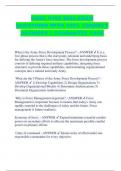CGSC X100 2024 EXAM
QUESTIONS WITH 100% CORRECT
ANSWERS || GUARANTEE PASS
What is the Army Force Development Process? - ANSWER ✔ It is a
five-phase process that is the start point, rationale and underlying basis
for defining the Army's force structure. The force development process
consists of defining required military capabilities, designing force
structures to provide these capabilities, and translating organizational
concepts into a trained and ready Army.
What are the 5 Phases of the Army Force Development Process? -
ANSWER ✔ 1) Develop Capabilities 2) Design Organizations 3)
Develop Organizational Models 4) Determine Authorizations 5)
Document Organization Authorizations
Why is Force Management important? - ANSWER ✔ Force
Management is important because it ensures that today's Army can
rapidly respond to the challenges of today and the future. Force
management is future readiness.
Economy of force: - ANSWER ✔ Expend minimum-essential combat
power on secondary efforts to allocate the maximum possible combat
power on primary efforts.
Unity of command - ANSWER ✔ Ensure unity of effort under one
responsible commander for every objective.
,Security - ANSWER ✔ Prevent the enemy from acquiring an
unexpected advantage.
Surprise - ANSWER ✔ Strike at a time or place or in a manner for
which the enemy is unprepared.
Simplicity - ANSWER ✔ Increase the probability that plans and
operations will be executed as intended by preparing clear,
uncomplicated plans and concise orders.
Restraint - ANSWER ✔ Limit collateral damage and prevent the
unnecessary use of force.
Perseverance - ANSWER ✔ Ensure the commitment necessary to attain
the national strategic end state.
Legitimacy - ANSWER ✔ Maintain legal and moral authority in the
conduct of operations.
12 Principles of Joint Operations - ANSWER ✔ Objective, Offensive,
Mass, Maneuvers, Economy of force, Unity of command, Security,
Surprise, Simplicity, Restraint, Perseverance, and Legitimacy
Unified Land Operations - ANSWER ✔ Simultaneous offensive,
defensive, and stability or defense support of civil authorities' task to
seize, retain, and exploit the initiative to shape the operational
environment, prevent conflict, consolidate gains, and win our Nation's
wars as part of unified
Decisive Action - ANSWER ✔ Continuous, simultaneous combination
offensive, defensive, and stability or defense support of civil authorities'
task.
,Decisive Action Task - ANSWER ✔ Offense, Defense, Stability, and
Defense support of civil authorities (DSCA)
Principles of Unified Land Operations - ANSWER ✔ Mission
command, develop the situation through action, combined arms,
adherence to the laws of war, establish and maintain security, and create
multiple dilemmas for the enemy.
Principles of Mission Command - ANSWER ✔ Build cohesive team,
create a shared understanding and a mutual trust, provide a clear
commander's intent, exercise disciplined initiative, use mission orders,
accept prudent risk
Tenets of Unified Land Operations - ANSWER ✔ Simultaneity, Depth,
Synchronization, and Flexibility
Simultaneity - ANSWER ✔ Execution of related and mutually
supporting tasks at the same time across multiple locations and domains
Depth - ANSWER ✔ Extension of operations in time, space, or purpose
to achieve definitive results
Synchronization - ANSWER ✔ Arrangement of military actions in
time, space, and purpose to produce maximum relative combat power at
a decisive place and time
Flexibility - ANSWER ✔ Employment of a versatile mix of
capabilities, formations, and equipment for conducting operations.
Operational framework - ANSWER ✔ Cognitive tool used to assist
commanders and staffs in clearly visualizing and describing the
application of combat power in time, space, purpose, and resources in
the concept of operations
, Elements of Combat Power - ANSWER ✔ Leadership, information,
mission command, movement and maneuver, intelligence, fires,
sustainment, and protection
Warfighing functions - ANSWER ✔ Mission command (center),
movement and maneuver, protection, sustainment, fires, intelligence
Mission command - ANSWER ✔ Exercise of authority and direction by
the commander using mission orders to enable disciplined initiative
within the commander's intent to empower agile and adaptive leaders in
the conduct of unified land operations
Combat power - ANSWER ✔ Leadership, information, and the six
warfighting functions (mission command, movement and maneuvers,
sustainment, fires, intelligences, and protection)
Commander's Activities - ANSWER ✔ Visualize, Describe, and Direct,
Plan, Prepare, and Assess
Commanders Intent - ANSWER ✔ Expanded purpose, Key Task, and
End State
What are the elements of Operational Art? - ANSWER ✔ Tools to help
the commander understand, visualize and describe their operational
approach to get to the desired end state of a military operation. (*
indicates element also found in operational design)
End state and conditions
Center of gravity*
Decisive points*
Lines of operations and lines of effort*
Basing
Tempo




